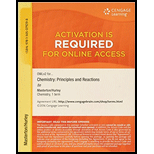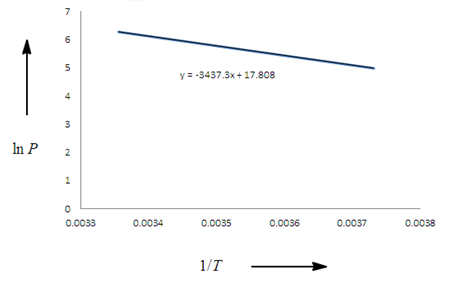
CHEMISTRY:PRIN.+REACTIONS-OWLV2 ACCESS
8th Edition
ISBN: 9781305079298
Author: Masterton
Publisher: Cengage Learning
expand_more
expand_more
format_list_bulleted
Concept explainers
Textbook Question
Chapter 9, Problem 14QAP
Consider the following data for the vapor pressure of diethyl ether, a widely used anesthetic in the early days of surgery.

Follow the instructions in Question 13 to estimate the heat of vaporization of diethyl ether.
Expert Solution & Answer
Want to see the full answer?
Check out a sample textbook solution
Students have asked these similar questions
Identify the molecule as having a(n) E, Z, cis, or trans configuration.
H₂C-
CH3
О Е
○ cis
○ trans
The decomposition of dinitrogen pentoxide according to the equation:
50°C
2 N2O5(g)
4 NO2(g) + O2(g)
follows first-order kinetics with a rate constant of 0.0065 s-1. If the initial
concentration of N2O5 is 0.275 M, determine:
the final concentration of N2O5 after 180 seconds.
...
Don't used hand raiting
Chapter 9 Solutions
CHEMISTRY:PRIN.+REACTIONS-OWLV2 ACCESS
Ch. 9 - Prob. 1QAPCh. 9 - Prob. 2QAPCh. 9 - The vapor pressure of I2(s) at 30C is 0.466 mm Hg....Ch. 9 - Prob. 4QAPCh. 9 - Trichloroethane, C2H3Cl3 is used as a degreaser...Ch. 9 - p-Dichlorobenzene, C6H4Cl2, can be one of the...Ch. 9 - Prob. 7QAPCh. 9 - Dichloromethane, CH2Cl2,is widely used as a...Ch. 9 - Prob. 9QAPCh. 9 - Prob. 10QAP
Ch. 9 - At a resort in Sante Fe, New Mexico, the...Ch. 9 - Prob. 12QAPCh. 9 - Prob. 13QAPCh. 9 - Consider the following data for the vapor pressure...Ch. 9 - Referring to Figure 9.7, state what phase(s)...Ch. 9 - Referring to Figure 9.7, state what phase(s) is...Ch. 9 - Prob. 17QAPCh. 9 - Consider the phase diagram of the compound in...Ch. 9 - Prob. 19QAPCh. 9 - Prob. 20QAPCh. 9 - Given the following data about xenon,...Ch. 9 - Given the following data about CO2: • triple...Ch. 9 - A pure substance X has the following properties:...Ch. 9 - Prob. 24QAPCh. 9 - Prob. 25QAPCh. 9 - Arrange the following compounds in order of...Ch. 9 - Which of the following would you expect to show...Ch. 9 - Which of the following compounds would you expect...Ch. 9 - Prob. 29QAPCh. 9 - Prob. 30QAPCh. 9 - Explain in terms of forces between structural...Ch. 9 - Prob. 32QAPCh. 9 - Prob. 33QAPCh. 9 - In which of the following processes is it...Ch. 9 - For each of the following pairs, choose the member...Ch. 9 - Follow the directions for Question 35 for the...Ch. 9 - What are the strongest attractive forces that must...Ch. 9 - What are the strongest attractive forces that must...Ch. 9 - Prob. 39QAPCh. 9 - Prob. 40QAPCh. 9 - Of the four general types of solids, which one(s)...Ch. 9 - Of the four general types of solids, which one(s)...Ch. 9 - Prob. 43QAPCh. 9 - Prob. 44QAPCh. 9 - Give the formula of a solid containing Si that is...Ch. 9 - Prob. 46QAPCh. 9 - Prob. 47QAPCh. 9 - Describe the structural units in (a) C (graphite)...Ch. 9 - Molybdenum has an atomic radius of 0.145 nm. The...Ch. 9 - Nickel has an atomic radius of 0.162 nm. The edge...Ch. 9 - Lead (atomicradius=0.181nm) crystallizes with a...Ch. 9 - Iridium crystallizes in a face-centered unit cell....Ch. 9 - In the LiCl structure shown in Figure 9.21, the...Ch. 9 - Potassium iodide has a unit cell similar to that...Ch. 9 - Prob. 55QAPCh. 9 - Consider the CsCl cell (Figure 9.21). The ionic...Ch. 9 - Consider the sodium chloride unit cell shown in...Ch. 9 - Consider the CsCl unit shown in Figure 9.21. How...Ch. 9 - A 1.25-L clean and dry flask is sealed. The air in...Ch. 9 - Aluminum metal crystallizes with a face-centered...Ch. 9 - Consider a sealed flask with a movable piston that...Ch. 9 - Prob. 62QAPCh. 9 - Prob. 63QAPCh. 9 - Prob. 64QAPCh. 9 - Chloroform, CHCl3, has a normal boiling point of...Ch. 9 - Prob. 66QAPCh. 9 - Prob. 67QAPCh. 9 - In the blanks provided, answer the questions...Ch. 9 - Answer the questions below, by filling in the...Ch. 9 - Prob. 70QAPCh. 9 - Prob. 71QAPCh. 9 - What is the difference between (a) a covalent bond...Ch. 9 - Four shiny solids are labeled A, B, C, and D....Ch. 9 - Prob. 74QAPCh. 9 - The following data are given for CC14:...Ch. 9 - Iron crystallizes in a body-centered unit cell....Ch. 9 - Prob. 77QAPCh. 9 - Trichloroethane, C2H3Cl3, is the active ingredient...Ch. 9 - Prob. 79QAPCh. 9 - Prob. 80QAPCh. 9 - Prob. 81QAP
Knowledge Booster
Learn more about
Need a deep-dive on the concept behind this application? Look no further. Learn more about this topic, chemistry and related others by exploring similar questions and additional content below.Similar questions
- CS2(g) →CS(g) + S(g) The rate law is Rate = k[CS2] where k = 1.6 × 10−6 s−¹. S What is the concentration of CS2 after 5 hours if the initial concentration is 0.25 M?arrow_forwardCS2(g) → CS(g) + S(g) The rate law is Rate = k [CS2] where k = 1.6 × 10-6 s−1. S Calculate the half-life.arrow_forwardThe following is a first order reaction where the rate constant, k, is 6.29 x 10-3 min-*** What is the half-life? C2H4 C2H2 + H2arrow_forward
- Control Chart Drawing Assignment The table below provides the number of alignment errors observed during the final inspection of a certain model of airplane. Calculate the central, upper, and lower control limits for the c-chart and draw the chart precisely on the graph sheet provided (based on 3-sigma limits). Your chart should include a line for each of the control limits (UCL, CL, and LCL) and the points for each observation. Number the x-axis 1 through 25 and evenly space the numbering for the y-axis. Connect the points by drawing a line as well. Label each line drawn. Airplane Number Number of alignment errors 201 7 202 6 203 6 204 7 205 4 206 7 207 8 208 12 209 9 210 9 211 8 212 5 213 5 214 9 215 8 216 15 217 6 218 4 219 13 220 7 221 8 222 15 223 6 224 6 225 10arrow_forwardCollagen is used to date artifacts. It has a rate constant = 1.20 x 10-4 /years. What is the half life of collagen?arrow_forwardיווי 10 20 30 40 50 60 70 3.5 3 2.5 2 1.5 1 [ppm] 3.5 3 2.5 2 1.5 1 6 [ppm] 1 1.5 -2.5 3.5arrow_forward
- 2H2S(g)+3O2(g)→2SO2(g)+2H2O(g) A 1.2mol sample of H2S(g) is combined with excess O2(g), and the reaction goes to completion. Question Which of the following predicts the theoretical yield of SO2(g) from the reaction? Responses 1.2 g Answer A: 1.2 grams A 41 g Answer B: 41 grams B 77 g Answer C: 77 grams C 154 g Answer D: 154 grams Darrow_forwardPart VII. Below are the 'HNMR, 13 C-NMR, COSY 2D- NMR, and HSQC 2D-NMR (similar with HETCOR but axes are reversed) spectra of an organic compound with molecular formula C6H1003 - Assign chemical shift values to the H and c atoms of the compound. Find the structure. Show complete solutions. Predicted 1H NMR Spectrum 4.7 4.6 4.5 4.4 4.3 4.2 4.1 4.0 3.9 3.8 3.7 3.6 3.5 3.4 3.3 3.2 3.1 3.0 2.9 2.8 2.7 2.6 2.5 2.4 2.3 2.2 2.1 2.0 1.9 1.8 1.7 1.6 1.5 1.4 1.3 1.2 1.1 f1 (ppm) Predicted 13C NMR Spectrum 100 f1 (ppm) 30 220 210 200 190 180 170 160 150 140 130 120 110 90 80 70 -26 60 50 40 46 30 20 115 10 1.0 0.9 0.8 0 -10arrow_forwardQ: Arrange BCC and Fec metals, in sequence from the Fable (Dr. R's slides) and Calculate Volume and Density. Aa BCC V 52 5 SFCCarrow_forward
arrow_back_ios
SEE MORE QUESTIONS
arrow_forward_ios
Recommended textbooks for you

 Chemistry: Principles and ReactionsChemistryISBN:9781305079373Author:William L. Masterton, Cecile N. HurleyPublisher:Cengage Learning
Chemistry: Principles and ReactionsChemistryISBN:9781305079373Author:William L. Masterton, Cecile N. HurleyPublisher:Cengage Learning Chemistry: The Molecular ScienceChemistryISBN:9781285199047Author:John W. Moore, Conrad L. StanitskiPublisher:Cengage Learning
Chemistry: The Molecular ScienceChemistryISBN:9781285199047Author:John W. Moore, Conrad L. StanitskiPublisher:Cengage Learning Introductory Chemistry: A FoundationChemistryISBN:9781337399425Author:Steven S. Zumdahl, Donald J. DeCostePublisher:Cengage Learning
Introductory Chemistry: A FoundationChemistryISBN:9781337399425Author:Steven S. Zumdahl, Donald J. DeCostePublisher:Cengage Learning Chemistry by OpenStax (2015-05-04)ChemistryISBN:9781938168390Author:Klaus Theopold, Richard H Langley, Paul Flowers, William R. Robinson, Mark BlaserPublisher:OpenStax
Chemistry by OpenStax (2015-05-04)ChemistryISBN:9781938168390Author:Klaus Theopold, Richard H Langley, Paul Flowers, William R. Robinson, Mark BlaserPublisher:OpenStax Introduction to General, Organic and BiochemistryChemistryISBN:9781285869759Author:Frederick A. Bettelheim, William H. Brown, Mary K. Campbell, Shawn O. Farrell, Omar TorresPublisher:Cengage Learning
Introduction to General, Organic and BiochemistryChemistryISBN:9781285869759Author:Frederick A. Bettelheim, William H. Brown, Mary K. Campbell, Shawn O. Farrell, Omar TorresPublisher:Cengage Learning


Chemistry: Principles and Reactions
Chemistry
ISBN:9781305079373
Author:William L. Masterton, Cecile N. Hurley
Publisher:Cengage Learning

Chemistry: The Molecular Science
Chemistry
ISBN:9781285199047
Author:John W. Moore, Conrad L. Stanitski
Publisher:Cengage Learning

Introductory Chemistry: A Foundation
Chemistry
ISBN:9781337399425
Author:Steven S. Zumdahl, Donald J. DeCoste
Publisher:Cengage Learning

Chemistry by OpenStax (2015-05-04)
Chemistry
ISBN:9781938168390
Author:Klaus Theopold, Richard H Langley, Paul Flowers, William R. Robinson, Mark Blaser
Publisher:OpenStax

Introduction to General, Organic and Biochemistry
Chemistry
ISBN:9781285869759
Author:Frederick A. Bettelheim, William H. Brown, Mary K. Campbell, Shawn O. Farrell, Omar Torres
Publisher:Cengage Learning
Types of Matter: Elements, Compounds and Mixtures; Author: Professor Dave Explains;https://www.youtube.com/watch?v=dggHWvFJ8Xs;License: Standard YouTube License, CC-BY